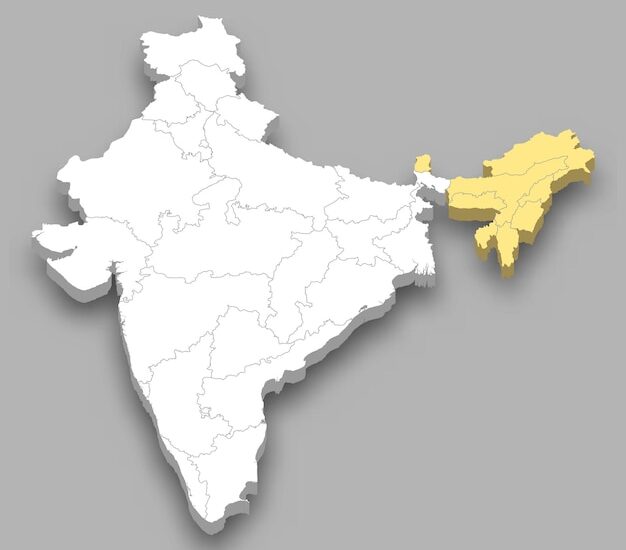The northeastern region of India, comprising states such as Assam, Nagaland, Manipur, Mizoram, Meghalaya, Tripura, Arunachal Pradesh, and Sikkim, is known for its unique culture, ethnic diversity, and distinct lifestyle. Over the years, there has been a noticeable shift in the region towards Westernized ways of living, both in terms of fashion, lifestyle choices, and overall societal norms. But why are people from North-East India often perceived as more Westernized compared to other parts of the country? In this blog, we will explore the factors that have contributed to this phenomenon.
1. Historical Influence of British Colonial Rule
The influence of British colonialism on the North-Eastern states of India has been profound. The region’s proximity to Myanmar, China, and Southeast Asia meant it was a crucial part of the British Raj’s geopolitical interests. As a result, the British left their mark on many aspects of life, from infrastructure to education. The establishment of schools, railways, and government offices created opportunities for exposure to Western ideas, technology, and lifestyle.
The British also encouraged the local elites to embrace English, which became a language of governance and education. Over time, English-speaking communities in the North-East became more familiar with Western values, leading to the adoption of certain practices from Western cultures.
2. Geographical Proximity to Southeast Asia
North-East India shares geographical and cultural links with Southeast Asia, including countries like Myanmar, Thailand, and Vietnam. This region has historically been a melting pot for trade, migration, and cultural exchange. The influence of Southeast Asia, combined with the proximity to Western countries, has exposed the region to more diverse lifestyles, practices, and ideas.
These cultural exchanges have encouraged a more globalized worldview. Many individuals from North-East India have had opportunities to travel abroad, experience different cultures firsthand, and return with more Westernized perspectives on fashion, behavior, and social practices. This exposure has helped shape the region’s modern identity.
3. The Role of Education and Urbanization
One of the driving forces behind the Westernization of North-East India is the region’s high literacy rate and the prominence of English in education. A significant portion of the population, especially in urban areas, receives education in English-medium schools and universities, which often incorporate Western curricula and teaching methods.
Moreover, cities like Guwahati, Imphal, and Shillong, have become bustling hubs of commerce, culture, and technology, which further promotes exposure to Western trends. Young people from North-East India are more likely to travel for work or study opportunities abroad, and upon returning, they bring back ideas and lifestyle choices that align more with Western ideals.
4. Influence of Media and Popular Culture
The advent of satellite television, the internet, and social media has dramatically changed the way people in North-East India consume entertainment. International content, including Hollywood films, Western TV shows, music, and fashion, is widely accessible and has significantly influenced the younger generations.
As a result, North-Eastern youth are more likely to follow global fashion trends, listen to international music, and watch Western movies and series. This exposure not only entertains but also shapes their worldview, encouraging them to adopt certain aspects of Western culture while blending them with traditional practices.
5. The Role of the Youth in Cultural Transformation
The youth of North-East India, in particular, are at the forefront of this cultural transformation. Many young people in the region have adopted a more cosmopolitan lifestyle, balancing their indigenous customs with Western influences. Western clothing, such as jeans, t-shirts, and dresses, have become a common sight, and social gatherings and celebrations often reflect global trends.
Additionally, North-Eastern youth are increasingly involved in international careers in fields such as business, technology, design, and entertainment, which exposes them to Western work environments and cultural norms. Their exposure to global cultures fosters a more Westernized lifestyle, and they often serve as bridges, integrating global and local influences into their communities.
6. Economic Development and Globalization
In recent decades, the growing economic development in North-East India has opened doors for greater integration into the global economy. As businesses in the region embrace modern technologies and practices, Western-style work environments and business models have also become more common.
This economic growth has attracted investment, both from within India and abroad, fostering greater connections with the global market. These economic ties create opportunities for North-Eastern people to travel, work, and engage with different cultures, further promoting Westernized practices.
7. The Changing Fashion Landscape
Fashion is another area where the influence of Western culture is evident in North-East India. While traditional clothing such as the mekhela chadar in Assam and the phanek in Manipur remain important, Western fashion trends are increasingly being embraced, particularly by the youth. Jeans, t-shirts, and western-style dresses are now part of everyday attire.
However, what is unique about the fashion trends in North-East India is the fusion of Western and traditional styles. Many young people in the region have creatively blended traditional garments with contemporary Western clothing, creating a hybrid style that reflects both their heritage and modernity.
8. Religious and Social Openness
In comparison to some other parts of India, North-East India tends to be more socially liberal. The region has a higher level of acceptance of diverse beliefs, lifestyles, and practices. Many North-Eastern states have a higher percentage of people who follow Christianity, and the region’s openness to different religions and social practices aligns more with Western notions of pluralism and liberalism.
This openness has also contributed to a more Westernized perspective on gender roles, marriage, and family dynamics. For example, there is often a more progressive approach to women’s rights, with women in North-East India enjoying a relatively higher degree of independence and equality compared to other regions.
9. Western Influence on Food and Culinary Preferences
While traditional Assamese and North-Eastern cuisine continues to hold a special place in the hearts of the people, there is a noticeable shift toward global food choices. Fast food chains, international coffee shops, and Western-style restaurants are increasingly popular in urban centers. Pizza, burgers, and pasta have become staples for many, particularly among the younger generation.
The blending of local flavors with Western culinary styles is also common. Traditional dishes like rice and fish are often combined with international ingredients, reflecting the region’s openness to experimenting with different food cultures.
The Westernization of North-East India is a result of a complex blend of historical, cultural, and socio-economic factors. From the influence of British colonialism to the region’s geographical proximity to Southeast Asia and the growing impact of globalization, North-East Indians have embraced many aspects of Western culture. While this may make the region seem more Westernized, it’s important to remember that the culture of North-East India is not homogenous and continues to retain its unique traditions, languages, and values. The fusion of Western influences with traditional practices has led to a dynamic cultural landscape that reflects both global and local trends.









